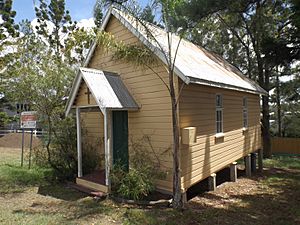Sinnamon Memorial Uniting Church facts for kids
Quick facts for kids Sinnamon Memorial Uniting Church |
|
|---|---|
| Seventeen Mile Rocks Church | |

Sinnamon Memorial Uniting Church, 2014
|
|
| 27°32′18″S 152°57′06″E / 27.5382°S 152.9516°E | |
| Country | Australia |
| Denomination | Uniting |
| Previous denomination | Methodist |
| History | |
| Former name(s) | Rocks Road Sinnamon Memorial Methodist Church |
| Status | Church |
| Architecture | |
| Completed | 1888 |
| Specifications | |
| Materials | Chamferboard; corrugated iron |
| Administration | |
| Parish | Centenary (Middle Park) |
| Presbytery | Bremer Brisbane |
| Synod | Queensland |
The Sinnamon Memorial Uniting Church is a special old church in Sinnamon Park, Brisbane, Australia. It's called 'heritage-listed' because it's an important historical building. This means it's protected to keep its history alive. The church was built in 1888 by a person named Wilson Henry. It is also known as the Seventeen Mile Rocks Church. It became part of the Queensland Heritage Register on October 21, 1992.
Contents
History of the Church
How the Church Started
In 1888, this church building replaced an older, smaller chapel. That first chapel was made from tree bark and wooden shingles. It was built in 1880 near the old Seventeen Mile Rocks School.
The new church was built by Wilson Henry. He was a local person and related to the Sinnamon family. The Sinnamon family were some of the first settlers in the Seventeen Mile Rocks area, arriving in the mid-1860s.
Early Church Services
The new building was first meant for the Church of England. However, they couldn't find a minister to lead services there. So, the church was instead used by the Primitive Methodist Church from Ipswich. Their minister would even arrive by rowboat!
Moving the Church Building
By the 1950s, not many people attended the church. Only two sisters, Edith and Isobel Sinnamon, were usually there. In 1966, a new road was being built to the suburb of Jindalee. This meant the church building had to be moved.
Hercules V. Sinnamon, from the original Sinnamon family, donated land for the church. This land was part of their family's first property from 1865. Two years later, in 1968, the church reopened. It was renamed the Rocks Road Sinnamon Memorial Methodist Church. Even without a regular group of people, it was used for special events.
Celebrating 100 Years
In 1980, the church celebrated its 100th birthday. To mark this special occasion, pine trees were planted all around the church building. The Sinnamon family and their relatives had been very involved with the church for many years. Because of their strong connection, it was very fitting that the church was moved and renamed in their memory.
What the Church Looks Like
Building Features
This church is a small building made of chamferboard, which is a type of wooden siding. It sits on concrete stumps, set back from Seventeen Mile Rocks Road. The area around it is grassy, with the pine trees planted more recently.
The church has a simple rectangular shape. There's a small porch at the front. The main roof and the porch roof are steeply sloped. They were originally covered with wooden shingles, but now they have corrugated iron.
Inside the Church
Inside, the ceiling is made of wooden boards. The walls are made stronger with two iron bars. The wooden frame of the building, which used to be visible inside, is now covered with boards.
The church still has some of its original furniture. This includes four silver-plated kerosene lamps with tin shades. There's also a medium-sized harmonium, which is like a small organ. The pulpit, where the minister speaks, is simple and made of cedar wood. It's raised on a platform with two steps. The church could seat about sixty people on its twelve pine pews, which are now painted. It's a great example of a small church from a rural area in the late 1800s.
Why the Church is Special
Heritage Protection
The Sinnamon Memorial Uniting Church is considered very important. It was listed on the Register of the National Trust of Australia (Queensland) in 1980. It was also added to the Queensland Heritage Buildings Protection Act in 1990. On October 21, 1992, it was officially listed on the Queensland Heritage Register. Later, in 2000, it was added to the Brisbane Heritage Register.
When it was listed on the Queensland Heritage Register in 1992, it met several important requirements:
- It shows how Queensland's history developed.
The church played an important role in the Seventeen Mile Rocks area. It shows how the community grew as a close-knit farming area in the late 1800s.
- It is a rare or uncommon part of Queensland's history.
This building helps create a rare rural landscape in Brisbane. It's part of a group of old farmhouses, a church, a school, and farmland from the late 1800s. This is special because the area around it is now a modern suburban district.
- It shows the main features of its type of building.
The church is a good example of a small, rural chapel from the late 1800s. It still has a strong connection to the Seventeen Mile Rocks area.
- It has a special link to important people or groups in Queensland's history.
The church is closely connected to the Sinnamon family. They were among the first people to settle in the area and have always had a strong presence there.

